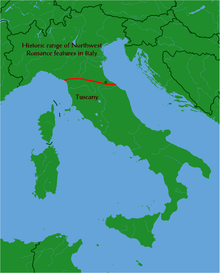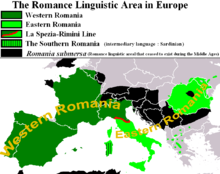- La Spezia-Rimini Line
-
The La Spezia–Rimini Line (sometimes also referred to as the Massa–Senigallia Line), in the linguistics of the Romance languages, is a line that demarcates a number of important isoglosses that distinguish Romance languages south and east of the line from Romance languages north and west of it. Romance languages on the eastern half of it include Italian and the Eastern Romance languages (Romanian, Aromanian, Megleno-Romanian, Istro-Romanian), while Spanish, French, Catalan, Portuguese as well as Gallo‒Italic languages are representatives of the western group. It has been suggested that the origin of these developments is to be found in the last decades of the Western Roman Empire and the Ostrogothic Kingdom (ca. 395-535 CE). During this period, the area of Italy north of the line was dominated by an increasingly Germanic Roman Army of (Northern) Italy, followed by the Ostrogoths; while the Roman Senate and Roman Catholic Church became the dominant social elements south of the line. As for the provinces outside Italy, the social influences in Gaul and Iberia were broadly similar to those in Northern Italy, while the Balkans were dominated by the Byzantine Empire at this time (and later, by Slavic peoples).
The line runs through northern Italy, very roughly from the cities of La Spezia to Rimini (some linguists say[1] that the line actually runs through Massa and Senigallia about 40 kilometres further to the south, and would more accurately be called the Massa–Senigallia Line).
North and west of the line (excluding some[citation needed] Northern Italian varieties, such as Ligurian, which probably once had the characteristic but lost it under influence from standard Italian), the plural of nouns was drawn from the Latin accusative case, and is marked with /s/ regardless of grammatical gender or declension. South and east of the line, the plurals of nouns were usually taken from the Latin nominative case, and plurals are marked with vowels. Compare the plurals of cognate nouns in Romanian, Italian, Spanish, Portuguese, Catalan, French and Latin:
Romanian Italian Spanish Portuguese Catalan French Latin (nom. pl.) Latin (acc. pl.) meaning viaţă, vieţi vita, vite vida, vidas vida, vidas vida, vides vie, vies vitae vitās life, lives lup, lupi lupo, lupi lobo, lobos lobo, lobos llop, llops loup, loups lupī lupōs wolf, wolves om, oameni uomo, uomini hombre, hombres homem, homens home, homes/hòmens homme, hommes hominēs hominēs man, men Generally speaking the western Romance languages show common innovations that the eastern Romance languages tend to lack. Another isogloss that falls on the La Spezia–Rimini line deals with the restructured voicing of voiceless consonants that occur between vowels. Thus, Latin catēna ('chain') becomes catena in Italian and catenă or cătină in Romanian, but cadeia in Portuguese, cadena in Catalan and Spanish and chaîne in French. Voicing, or further weakening, even to loss of these consonants is characteristic of the western branch of Romance; their retention is characteristic of eastern Romance. There are, however, exceptions which undermine this isogloss: Gascon dialects in south-west France and Aragonese in northern Aragon (Spain) — i.e. geographically Western Romance — also retain the original Latin voiceless stop between vowels. Indeed, the significance of the La Spezia–Rimini line is often challenged by specialists within both Italian dialectology and Romance dialectology. One reason for this is that while it demarcates preservation (and expansion) of phonemic geminate consonants (Central and Southern Italy) from their simplification (in Northern Italy, Gaul, and Iberia), the areas affected do not correspond consistently with those defined by voicing criteria. Romanian, which on the basis of lack of voicing is classified with Central and Southern Italian, has undergone simplification of geminates, a defining characteristic of Western Romance.
Notes
References
Note that the word Lombard once upon a time (up to 1600) meant Cisalpine, but now it has narrowed in its meaning, referring only to the administrative region of Lombardy .
- Adolfo, Mussafia (1873) Beitrag zur Kunde der norditalienischen Mundarten im XV. Jahrhunderte. Wien.
- Beltrami, Pierluigi; Bruno Ferrari, Luciano Tibiletti, Giorgio D'Ilario (1970) Canzoniere Lombardo. Varesina Grafica Editrice.
- Brevini, Franco (1984) Lo stile lombardo : la tradizione letteraria da Bonvesin da la Riva a Franco Loi. (Lombard style: literary tradition from Bonvesin da la Riva to Franco Loi.) Pantarei, Lugan.
- Comrie, Bernard; Stephen Matthews, Maria Polinsky, eds. (2003) The Atlas of languages : the origin and development of languages throughout the world. New York: Facts On File. p. 40.
- Cravens, Thomas D. (2002) Comparative Romance Dialectology: Italo-Romance clues to Ibero-Romance sound change. Amsterdam: Benjamins.
- Hull, Dr Geoffrey (1982) The linguistic unity of Northern Italy and Rhaetia. PhD thesis, University of Western Sydney.
- Hull, Dr Geoffrey (1989) Polyglot Italy: Languages, Dialects, Peoples. Melbourne: CIS Educational.
- Maiden, Martin (1995) A linguistic history of Italian. London: Longman.
- Maiden, Martin & Mair Parry, eds. (1997) The Dialects of Italy. London: Routledge.
- Sanga, Glauco La lingua Lombarda, in Koiné in Italia, dalle origini al 1500. (Koinés in Italy, from the origin to 1500.) Bèrghem: Lubrina.
- Vitale, Maurizio (1983) Studi di lingua e letteratura lombarda. (Studies in Lombard language and literature.) Pisa : Giardini.
- Wurm, Stephen A. (2001) Atlas of the World’s Languages in Danger of Disappearing. Paris: UNESCO Publishing, p. 29.
See also
Categories:
Wikimedia Foundation. 2010.


